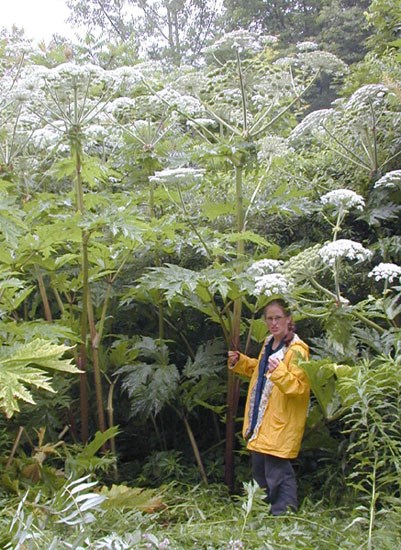Long ago in the Russian hills, a Victorian explorer found the regal Hogweed by a marsh. He captured it and brought it home. Soon they escaped, spreading their seed. Preparing for an onslaught, threatening the human race. excerpted from The Return of Giant Hogweed by Genesis.
Article
Species Spotlight - Giant Hogweed

USDA photo.
What is it?
Though in the same family as carrots, parsley, dill, and cilantro - giant hogweed is not something you’ll want to add to your salad or sprinkle onto your burrito. A fully grown giant hogweed, often described as Queen Anne’s lace on steroids, has leaves that can extend 5-feet wide, thick stalks topped with feathery umbrella-like flowers - and can grow to an impressive 15 feet tall. But its size isn’t what it’s most notorious for. The sap of giant hogweed causes phytophotodermatitis in humans due to the furocoumarin (a class of often toxic defensive organic chemical compounds produced by some plants) derivatives in the leaves, roots, stems, flowers, and seeds of the plant. When these chemicals come into contact with human skin they cause a reaction that leads to severe blistering if exposed to sunlight. Contact with the eyes can lead to temporary or even permanent blindness, and if inhaled the sap can cause respiratory problems. In short - don’t mess with this plant.Native to the Caucasus region of Russia and Central Asia, it was introduced to Europe and North America as a popular curiosity in ornamental gardens of the 19th and 20th centuries.
Why is it important?
Besides the public health concerns, giant hogweed can also be invasive under certain conditions. It does especially well in disturbed soils and along waterways where its seeds can spread long distances. The plant is on the Federal Noxious Weeds List, meaning it is illegal to sell or transport across state lines. Large colonies can form from a single plant due to a combination of high seed abundance and shoots popping up from the roots giving rise to dozens of offspring. Once established, it takes up to 5 years to completely eradicate a colony because of regrowth from seeds and roots.How does NETN monitor it?
Giant hogweed is on the Target Invasive Species lists for most Northeast Temperate Network (NETN) parks. The goal of the Early Detection of Invasive Species Program is to help NPS employees, contractors, and citizen scientists to detect invasive species while they are in the early stages of establishment and still relatively easy and economical to eradicate. To help do this, a short list of target insect pest and exotic plant species specific to each park has been developed. The lists include species that are either present in the park at low levels and of management concern if spreading is detected, or not present, but have demonstrated impacts to ecosystem function in the region.How can you get rid of it?
The wrong way to try to eradicate hogweed if you find it on your property would be to mow or weed-whack it down. Doing so would cause the toxic sap to be sprayed everywhere and the plants would just root-sprout again anyway. Either the roots have to be dug up or the plants have to be sprayed with an herbicide. Contacting local authorities or hiring a professional who can properly destroy the plant and its seeds is sometimes the best course of action, but if going it alone, take heed of the following advice. Flower heads have to be carefully cut, bagged and discarded in the trash. Make sure to wear gloves, long sleeves, pants, shoes and eye protection when controlling hogweed. If you get hogweed sap on your skin, wash it immediately and try to keep the exposed area out of the sun for at least couple of days.For more information
NETN helps monitor ecological conditions in 13 national parks located in seven northeastern states as well as the Appalachian National Scenic Trail. Natural resource monitoring in national parks provides site-specific information needed to better identify change in complex, variable, and imperfectly understood natural systems. It also makes it possible to determine if those changes are within natural levels of variability, or casued by something else (i.e - human induced climate change). Learn more about all the monitoring programs NETN condcuts in member parks, in addition to the Early Detection of Invasive Species program, at http://go.nps.gov/netn.Tags
- acadia national park
- eleanor roosevelt national historic site
- home of franklin d roosevelt national historic site
- marsh - billings - rockefeller national historical park
- minute man national historical park
- morristown national historical park
- saratoga national historical park
- vanderbilt mansion national historic site
- weir farm national historical park
- monitoring
- inventory and monitoring
- species spotlight
- exotic species
- invasive species
- netn
Last updated: June 13, 2018
